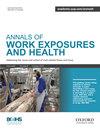129 评估木材加工环境中微生物污染职业暴露的采样规程
IF 2.1
4区 医学
Q3 PUBLIC, ENVIRONMENTAL & OCCUPATIONAL HEALTH
引用次数: 0
摘要
锯木厂市场受到建筑需求增长的推动,其中建筑和家具的需求日益突出。锯木行业的工人可能会接触到木材衍生物、微生物及其产物,从而对健康造成影响,如肺功能下降、支气管高反应性和各种呼吸系统疾病。接触受微生物(尤其是真菌)感染的木屑会导致木工患上过敏性肺泡炎和哮喘。众所周知,在锯木厂微生物职业接触评估领域还存在知识空白,然而,准确评估和风险管理的重要性应该得到强调。本研究采用的取样方法包括多种取样方法,这些方法相互补充,克服了各自的优缺点。这些方法包括主动采样方法(如安徒生六级采样器、MAS-100 和按钮采样器)和被动采样方法(即表面棉签、静电除尘布 (EDC)、T恤中的 EDC、沉淀粉尘、手套和口罩以及吸尘沉淀粉尘的过滤器)。这种采样方法是为适用于木材加工环境而开发的,它是利用以前进行的文献研究精心制定的,并应用于在设有木材切割区的 "自己动手"(DIY)商店和锯木厂开展的采样活动中。通过应用这一综合规程,可以得出结论:同时使用所有这些取样方法对于克服每种方法的局限性以正确描述这些工人所面临的风险至关重要。在选择最佳实验室方法时也应考虑类似因素。本文章由计算机程序翻译,如有差异,请以英文原文为准。
129 Sampling protocol to assess occupational exposure to microbial contamination in wood working environments
The sawmill market is driven by rising construction demand, with building and furniture gaining prominence. Workers in the sawmill industry may be exposed to wood derivatives, microorganisms, and their products, which can cause health effects such as decreased lung function, bronchial hyperresponsiveness, and various respiratory disorders. Exposure to wood dust infected with microorganisms, particularly fungi, can lead to allergic alveolitis and asthma in woodworkers. It is well known that there is a knowledge gap in the field of microbial occupational exposure assessment in sawmills, nevertheless, the importance of an accurate assessment and risk management should be emphasized. The sampling approach applied in this study comprehends several sampling methods that are used as a complement to overcome the advantages and disadvantages of each. Those methods are active sampling methods, such as Andersen six-stage, MAS-100 and Button Samplers, and passive sampling methods namely surface swabs, electrostatic dust cloths (EDC), EDC in t-shirts, settled dust, gloves and masks and filters from the vacuumed settled dust. This sampling approach was developed to be applied in wood working environment and it was meticulously developed using previously conducted bibliographic research and applied in sampling campaigns developed in “Do It Yourself” (DIY) stores with a wood cutting section, and in sawmills. With the application of this comprehensive protocol, it was possible to conclude that the use of all these sampling methods in parallel is crucial to overcome the constraints of each to allow a proper characterization of the risks to which these workers are exposed. Similar considerations should be taken to select the best lab approach.
求助全文
通过发布文献求助,成功后即可免费获取论文全文。
去求助
来源期刊

Annals Of Work Exposures and Health
Medicine-Public Health, Environmental and Occupational Health
CiteScore
4.60
自引率
19.20%
发文量
79
期刊介绍:
About the Journal
Annals of Work Exposures and Health is dedicated to presenting advances in exposure science supporting the recognition, quantification, and control of exposures at work, and epidemiological studies on their effects on human health and well-being. A key question we apply to submission is, "Is this paper going to help readers better understand, quantify, and control conditions at work that adversely or positively affect health and well-being?"
We are interested in high quality scientific research addressing:
the quantification of work exposures, including chemical, biological, physical, biomechanical, and psychosocial, and the elements of work organization giving rise to such exposures;
the relationship between these exposures and the acute and chronic health consequences for those exposed and their families and communities;
populations at special risk of work-related exposures including women, under-represented minorities, immigrants, and other vulnerable groups such as temporary, contingent and informal sector workers;
the effectiveness of interventions addressing exposure and risk including production technologies, work process engineering, and personal protective systems;
policies and management approaches to reduce risk and improve health and well-being among workers, their families or communities;
methodologies and mechanisms that underlie the quantification and/or control of exposure and risk.
There is heavy pressure on space in the journal, and the above interests mean that we do not usually publish papers that simply report local conditions without generalizable results. We are also unlikely to publish reports on human health and well-being without information on the work exposure characteristics giving rise to the effects. We particularly welcome contributions from scientists based in, or addressing conditions in, developing economies that fall within the above scope.
 求助内容:
求助内容: 应助结果提醒方式:
应助结果提醒方式:


